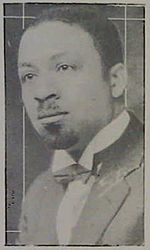Double-duty dollar facts for kids

The double duty dollar was a powerful idea in the United States from the early 1900s to the 1960s. It meant that when people spent their money at businesses that hired African Americans, their dollars did "double duty." They bought something they needed, and at the same time, they helped the African American community grow stronger. People who believed in this idea thought that businesses that refused to hire African Americans should not get their money.
Contents
What Was the Double Duty Dollar?
A Powerful Idea for Change
This idea became very popular thanks to Gordon B. Hancock, a professor at Virginia Union University. Many important leaders, like Booker T. Washington and Marcus Garvey, encouraged African Americans to spend their money wisely. They urged people to support businesses that hired African Americans, instead of those that did not.
How It Helped the Community
The main goal was to create more jobs and opportunities for African Americans. By choosing where to spend their money, people hoped to encourage businesses to treat everyone fairly. This also helped build up African American-owned businesses, creating more wealth within the community.
Selective Patronage
Later, in the 1940s and 1950s, Leon Sullivan used a similar idea called "selective patronage." This meant that customers would choose businesses that treated African Americans fairly and without discrimination. It was a way for people to use their spending power to push for positive change. It also helped create more demand for businesses owned by African Americans.
The Impact of the Double Duty Dollar
A Tool for Social Change
The "double duty dollar" was a form of consumer activism. It showed how people could use their everyday choices to fight for equality and justice. This strategy helped to challenge unfair practices and support the growth of African American communities.
Modern Connections
Even today, similar ideas are used by different groups. People might choose to support businesses that are environmentally friendly or that help local economies. The "double duty dollar" concept was an early example of how consumers can make a difference with their money. It showed that spending money can be about more than just buying things; it can also be about supporting important causes.

